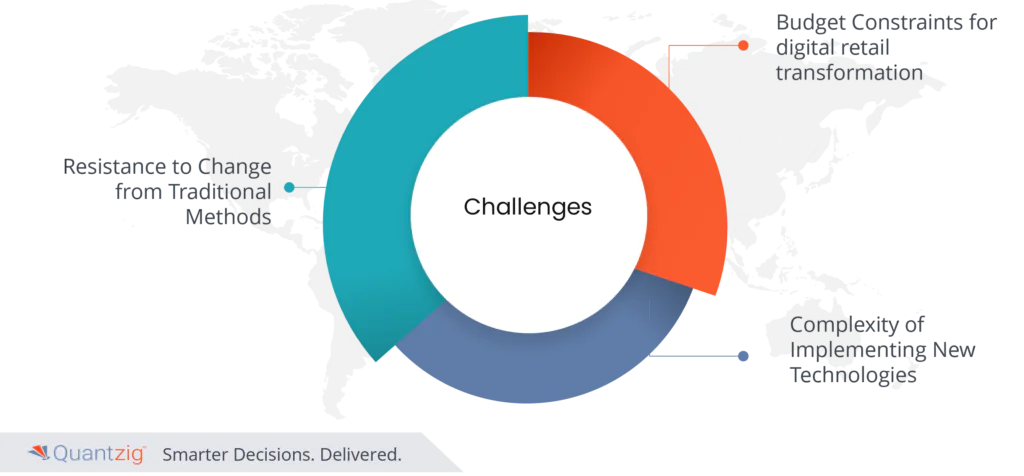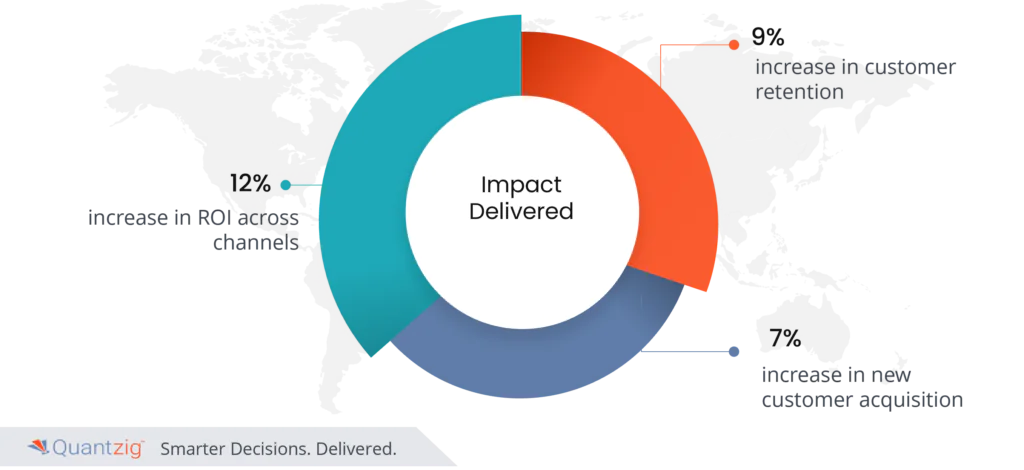Table of Contents
Introduction
In an era defined by rapid technological advancements and shifting consumer behaviors, the retail industry finds itself at a pivotal crossroads. The article delves into the vital realm of digital transformation in the retail sector, where innovation is not merely an option but an imperative for survival and success. As the digital landscape continues to evolve, retailers must harness the power of technology to revolutionize their operations, enhance customer experiences, and adapt to an ever-changing marketplace. Join us on this enlightening journey as we explore the digital transformation trends in retail and discover how digital retail transformation is not just a choice, but the lifeline that will determine who thrives in this dynamic industry.
Importance of Vital Digital Transformation in the Retail Industry:
In today’s hyper-connected world, an undeniable shift is underway as customers increasingly gravitate toward digital purchase options. This seismic change in consumer behavior is reshaping the retail landscape at an unprecedented pace. For retailers, adaptation is not a choice; it’s a vital necessity. To remain relevant and competitive, they must undergo a profound transformation. Embracing digital innovation is no longer a luxury but an imperative. Whether through e-commerce platforms, seamless mobile experiences, or personalized online engagement, retailers must meet customers where they are. In this digital metamorphosis lies the key to survival, relevance, and a thriving future in the ever-evolving market.
Challenges/Problems faced while implementing Digital Transformation in the Retail Industry:

Resistance to Change from Traditional Methods:
One of the primary challenges in implementing digital retail transformation is resistance to change from traditional methods. Established retail processes, systems, and mindsets can often be deeply ingrained. Employees and stakeholders may be hesitant to embrace new technologies and processes, fearing disruption or job displacement. Overcoming this resistance requires effective change management strategies, clear communication, and fostering a culture of adaptability.
Budget Constraints for Digital Retail Transformation:
Digital retail transformation initiatives can be capital-intensive, presenting a significant financial hurdle for retailers, especially smaller businesses. Budget constraints may impede the adoption of cutting-edge technologies and inhibit the scalability of digital projects. Successful implementation often requires careful financial planning, ROI analysis, and seeking cost-effective solutions to ensure sustainable transformation.
Complexity of Implementing New Technologies:
Incorporating emerging technologies like IoT, Augmented Reality (AR), and AI can be daunting due to their inherent complexity. These technologies often demand specialized skills for implementation and maintenance. Furthermore, end-users may find them challenging to navigate, potentially causing frustration. Retailers must invest in training and user-friendly interfaces to mitigate these complexities and ensure a seamless adoption experience, enhancing the chances of successful digital transformation.
Benefits of digital transformation in the retail Industry:
- Increased Customer Retention through Better Understanding: Implementing retail digital transformation equips retailers with powerful tools for gathering and analyzing customer data. By harnessing data analytics, retailers gain insights into customer behavior, needs, and preferences. This understanding allows for more targeted marketing efforts and personalized customer experiences. By tailoring products and promotions to individual preferences, retailers can enhance customer satisfaction and loyalty, leading to increased retention rates and sustained revenue growth.
- Proactive Identification of Market Trends: In the fast-paced world of retail, staying ahead of the competition is essential. Retail store digital transformation enables retailers to proactively identify market trends by leveraging real-time data analytics. Through data-driven insights, retailers can detect shifts in consumer behavior, emerging market trends, and competitive threats. This foresight empowers retailers to adapt quickly, refine strategies, and capitalize on emerging opportunities, thereby maintaining a competitive edge in a dynamic marketplace.
- Effective Marketing with Customer-Level Personalization: Retail digital transformation enables retailers to implement hyper-personalized marketing strategies. By segmenting and analyzing customer data, retailers can deliver highly targeted marketing campaigns. Personalized recommendations, tailored promotions, and relevant content can significantly boost conversion rates. This level of personalization fosters a deeper connection with customers, improving brand loyalty and driving sales growth.
- Efficient Inventory Management and Operations: Digital transformation streamlines inventory management and operations. Retailers can optimize stock levels, reduce carrying costs, and minimize stock-outs through data-driven insights. Automated systems help forecast demand, manage supplier relationships, and optimize order fulfillment processes. With improved warehouse management and accurate lead time predictions, retailers can operate with greater efficiency, ensuring products are available when and where customers need them. This not only enhances customer satisfaction but also reduces operational costs, ultimately improving profitability. In essence, digital transformation in the retail industry offers a multifaceted approach to improving customer satisfaction, competitiveness, and operational efficiency. By leveraging data and technology, retailers can create more personalized experiences, adapt to market changes, and streamline their operations, leading to sustained success in an ever-evolving retail landscape.
- Improved customer satisfaction using service chatbots: Elevating customer satisfaction through the deployment of swift and responsive chatbots is a game-changer in modern service provision. These AI-powered marvels revolutionize customer interactions by offering real-time assistance and lightning-fast query resolution. With 24/7 availability, chatbots ensure that customers’ needs are met promptly, irrespective of time zones or peak hours. This instant gratification not only enhances customer experience but also streamlines operations, reducing service wait times and human resource demands. In a digital age where speed is paramount, chatbots emerge as a vital tool, fostering higher customer satisfaction and loyalty by delivering seamless, rapid, and efficient service.
Conclusion
In the relentless march of progress, the retail industry stands at a critical juncture. The journey of vital digital transformation has been unveiled, illuminating the path to survival, relevance, and prosperity. As we conclude this exploration of innovation and adaptation, one thing becomes abundantly clear: the future belongs to those who embrace change. In the dynamic retail landscape, where consumer preferences evolve at the speed of technology, the choice is stark—evolve or fade away. Through digital transformation, retailers can not only meet but exceed customer expectations, proactively seize market opportunities, and redefine their destinies. Transformation is not just vital; it’s the beacon lighting the way forward in the retail renaissance.
Success Story
“Revolutionizing Retail: A Digital Retail Transformation Case Study “
Client Details:
A leading Retail company located in the USA.
Challenges
The client faced several significant challenges in their marketing efforts. Firstly, despite investing in multiple marketing channels, they were unable to achieve the expected return on investment (ROI). This suggests a lack of effectiveness and efficiency in their marketing strategies, which could be attributed to misaligned messaging, targeting issues, or inadequate tracking and analytics.
Secondly, the persistently high customer churn rate across channels indicated a deeper problem. It suggested that the client was struggling to retain and engage their customers effectively. This could be due to suboptimal customer experiences, inadequate customer relationship management, or failure to address customer pain points.
Overall, the challenges encompassed both strategic and operational aspects, requiring a holistic approach to revamp their marketing strategies, enhance customer engagement, and align their investments with the desired ROI outcomes.
Solutions
Quantzig’s implementation of the Customer 3.0 solution proved instrumental in catalyzing remarkable improvements for the client. By meticulously tracing the customer’s journey across various channels, our team enabled the client to gain profound insights into consumer behavior. Leveraging cutting-edge tools and methodologies under Customer Analytics 3.0, we identified and nurtured high-return consumer behaviors among omnichannel customers. This strategic focus on high ROI activities resulted in a substantial revenue uplift. Moreover, Quantzig’s solution facilitated precise and timely communication by triggering tailored messages through the most effective channels. By optimizing customer engagement, we not only enhanced the overall customer experience but also significantly increased the client’s revenue streams, demonstrating the tangible and transformative impact of their innovative Customer 3.0 solution.
Impact Delivered:

- 12% increase in ROI across channels.
- 9% increase in customer retention.
- 7% increase in new customer acquisition
Discover how Quantzig’s cutting-edge digital transformation solutions propelled the retailer into the future of retail. Explore the full case study to learn how we can transform your business too!


